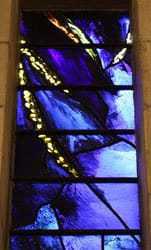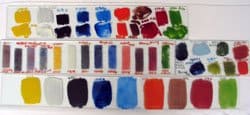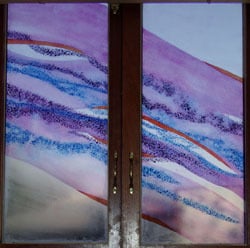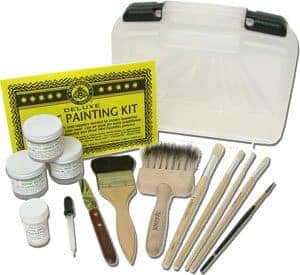Which Paint Is Best For Your Project?
Painting glass allows you to add infinite amounts of detail and texture to your stained glasswork. It opens up a whole variety of effects to you. It is fired permanently on to the surface of the glass in a kiln.
This is where you’ll learn about:
- the right paint for your stained glass project
- the different types of paints available
- when best to use them
- who makes them and where to buy them
What exactly is glass paint?

– Often called enamels or vitreous enamels, they are a mixture of metallic oxide pigments, flux and ground glass.
– They are used for surface decoration, and are fired on permanently in a kiln.
– Their colour and opacity depends on the type of metal oxide used.
– When painting glass, you need to use a face mask, as inhaling the dust is dangerous.
What types of glass paint are there?
There are masses of different types of paint, and lots of confusion as a result. Broadly, they’re divided into two main categories: opaque (that you can’t see through) and transparent paints.
Painting with opaque paints
1. Pigments
Firstly, there’s a range of various browns, black, and greys in what’s often called ‘glass pigments’. Reusche is expensive, but probably supply the best of this type of stained glass paint.
These paints are what you see used in church windows for drapery and facial features.
It sounds dull, but if you imagine some of the bright colours in your stained glassart partially covered with dramatic painting, you’ll understand how exciting this type of paint is.
Have a look at the John Piper window above – see how the dark painting has created an almost 3-D effect? And how the black paint actually makes the colours – particularly the yellow – stand out more vividly?
2. Colored Paint
The second type of opaque paints – more commonly called enamels – are coloured. There’s a huge range of colours and they vary between manufacturers, who each have several different types of enamel.

Some are high firing – suitable for use at fusing temperatures, some are lead-free – for tableware, and some are made for architectural applications and withstanding the weather.
Above are some tests of Range 34 Ferro enamels. You can see the colours are bright and varied. They’re best used in situations where privacy is needed, or where the light source is from in front – rather than through – them.
Johnson Matthey also makes three ranges of opaque enamels for architectural use.
Painting with transparent enamels

Transparent paints also come in a wide range of colours, and are best used for architectural work, with light comingthrough the glass.
The complaint I always hear from my students about transparent enamels, is that they are wishy-washy. They can be layered up and fired repeatedly to deepen their colour, but really it’s best not to compare them to coloured glass.
You’ll never achieve that gorgeous depth of colour or transparency that we all love, but they do have a charm and benefits of their own.
What painting with transparent paints does do, is to allow you to change colour within one piece of glass without the need for lead. And that can really free your designing up. Imagine not having to think about whether you can cut a certain shape, but just painting instead. Lovely!
Just like the opaques, there are lots of manufacturers of transparent paints.
I’ve used Ferro and Heraeus and prefer the colours achieved with the latter, although Ferro do a fantastic blue.
This commission window (above) for a narrow boat double door used Heraeus transparents.
Now you’re clear about what type of paint you need for your project, you’re ready for Perfect Paint Mixing
This Peter Mcgrain Deluxe Paint Starter Kit is available on Amazon



First, thank you for all the help. Is it possible to paint on glass with acrylic paint? As I do not have a kiln and really can’t afford one, plus I am 84 and enjoy creating with stained glass, I need to find a paint that does not require a kiln.
thank
Roger
Yes you can but it doesn’t look so great with the light behind it and it certainly isn’t anywhere near permanent. It comes off with the lightest of scratches.
Your best bet is glass paints – Pebeo Vitrea 160 is a water-based glass paint. You can bake at 160°C to make it semi permanent. The transparent ones are more ‘glassy’ – the opaque ones are good if you’re doing a piece that won’t have light behind it.
I hope that helps
Hello, Milly I have a question, is it posible to make glass strainers paint in a similar way to making ceramic glazes? Do you know if there is a powdered flux chemical that fires to 650 C that could be combined with pigments such as an oxide
Interesting question Hector. Sadly my chemistry training isn’t up to much (pretty much zero!) so I can’t help you here.
Hi Milly,
I am interested in trying traditional paints like Reuche, and I can’t find information about whether they have to be fired in a kiln. I know that some kinds can be fired in the oven and some in the microwave!
I am striking out after a couple days of research – and I know that you’ll have some answers!
Thanks in advance! You have the best website that I’ve ever run across – so inspiring, so helpful and so much fun!!!
xo Cecilia
Yes, you have to fire Reusche paints, at c.650C, depending on kiln’s behaviour.
Thank you Cecilia, what lovely words for me to read 🙂
Dear Molly,
Your site is very helpful. I live in a remote mountain valley in Chile and am making some stained glass windows for the local chapel. I have a small kiln for ceramics (Cromartie Kiln CTL40, firing at a max of 1300C) which I have used to fire Reusche Tracing Black on to glass, but what size pyrometric bars should I be using in the kiln? And if I don’t have the correct size, or if I run out of stock, is it OK to just fire up the kiln and switch the power off after an hour or so? Thanks.
You’ll have to ask the supplier which cone translates to 650C (or Farenheit equivalent) Rob. I wouldn’t just turn it on and off unless you have experience as to how the glass should look through the peep hole when it reaches the correct temperature.
Sorry I can’t be more specific this time.
Hi, I wondered if there was any kind of pen for permanent drawing onto glass, for detail on stained glas projects? Something fine and delicate that can be oven fired as I don’t have a kiln? Any suggestions welcome, thank you!
You could try Pebeo outliner Lois. I’m not sure if you’d be able to get a fine line with it though. All the paints I use for lines are fired in a kiln.
What would your recommendations be on making some panels for the top of a french style birdcage shaped gazebo in a deep blue, purple, and pastel pink?
What an interesting project Tiffany! I’m sorry but I can’t really visualise what you’re meaning but I do like the colours you’ve chosen. Sorry I can’t be of more help without a photo.
Hi Milly, can use any kind of glass to paint on? And do you know what the best quantities would be to make an oil based mix for dip pen work?
Thank you x
Yes you can use any glass to paint on – apart from glass that has been toughened or laminated as it can’t go in the kiln. Hope that helps, Milly
Thank you so much for all your information. This site has really been a life-saver for me. I am curious what you’d recommend for cold paints specifically. I’ve been doing glass about 3 years, but following the pandemic, my local makers-space has had to limit access to their kiln and I can rarely fire all my pieces at one time. I’ve never used cold paints, but I was wondering if you knew of any that were weatherproof (I make a lot of suncatchers people tend to hang in their gardens and on patios). Thank you in advance, much appreciated.
Pebeo are a good make Christopher. They’re only semi permanent after firing in a oven. They can be scraped off with a sharp implement but you have to try quite hard! I haven’t used them outside as I fire my paint so can’t answer that. Maybe someone else can or you could do a test and leave it in all sorts of test situations.
I find them good for specific things – small, solid areas – rather than the more subtle effects you can achieve with matting fired pigments.
I hope that helps.
As a child, my front doors had two olive green stained glass panels. These doors were installed in the 80s. I’ve recently bought a new set of front doors with two very large panes and I would like to recreate this look because it would match not only the door, but the second interior color of the house. Would you recommend staining both sides and what would you recommend? Thanks!
I’m not sure I understand the question James. Are you saying you want to paint the glass with glass paint? Or do you mean make stained glass in olive green stained glass? I wouldn’t recommend painting an outdoor piece unless it was permanently fired in a kiln.
Glass comes in coloured sheets and you can a buy olive green colour. That’s your most permanent option but you’d have to make sure it adhered to local safety standards.
Sorry I can’t be of more help this time.
Good day!
I am not a stained glass crafter, but have been asked to research a product that could replace the color in a simple glass window at our church. It looks like the colors just faded away.
What product might you recommend that we could paint on while the window stays in place?
Hi Marcey, there are some ‘cold’ coloured paints (cold because they don’t need a kiln to fire them) that might do the trick. Pebeo make a good range – their 160 glass paint is transparent – but it won’t be permanent.
I hope that helps.
Hello- do you know of a paint that fires at 500° I currently do not have access to a kiln and will need to set glass in my kitten oven.
I don’t Emily, even the low firing permanent ones fire at c.650 Centigrade. If you don’t mind semi-permanent, Pebeo 160 or 150 bake in an oven but you can scrape it off with a sharp implement after which may or may not matter to you.
Hi,
Thanks so much for posting your article.
Is there a way to stain glass frit which will not be fired in a kiln? I use clear transparent glass frit for crafts and I am Interested in staining clear glass frit into a color such as red and fuchsia tones because I have been having a hard time finding a ruby red color that looks ruby before firing.
Any thoughts would be greatly appreciated.
Thank you.
You can buy red frit Rachel. You don’t have to fire it you could use it for crafts. You can get frits in every colour. I hope that helps.
My husband was a well known stained glass artist in the Maritimes, Canada, but has parkinson’s and now cannot work. We are trying to put a price on his left over paints and stains but I don’t know where to start. Could you give me a nudge in the right direction?
Your best bet would be contacting a local stained glass artist who fires work. There aren’t so many of them about these days, sadly. In my experience, unless pots of paints and stains are in manufacturer’s pots with the product clearly labelled, it’s hard to get much for them. Are you talking large amounts?
Thank you Milly. Where do I purchase the Heraeus transparents enamel? Thank you.
I used to get them directly from Heraeus Molly. I had huge tubs which never ran out so haven’t ordered for so long. Warm Glass UK have a Heraeus pdf on their site so they might be able to help you https://www.warm-glass.co.uk/.
Hi There, I was wondering about patina enamel used for softening trace lines, but I can’t find any information as to when and how to use it, any info would be great, many thanks, Mairi
Hello Mairi, well I’m stumped. I haven’t ever used patina enamels on glass so can’t help, sorry. Does anyone else know? Comments welcome.
Hi im a porcelain painter and i want to paint on glass.
Can i paint glass with the porcelain pigments?
My kiln is okay for firing glass and porcelain but i dont know how to fire my painted glass in my kiln, one time it melted and the other time it didnt take the colors
Can you help me plz
I don’t have much experience with porcelain pigments. Once did experiments with onglazes – they worked. I don’t remember the temperature but I would guess that you’re not firing it high enough. You’ll have to experiment with small pieces that don’t matter to build up the specific information you need.
.very helpful
I’m just curious about chemical composition,what are these pigments made from ?
Thank you so much
Good question Tamaikhanh. The paints are a mixture of ground glass and various pigment oxides. Glad you found my tutorials helpful.
Tamaikhanh, that was me, Milly, commenting above, I accidentally used the incorrect login. Sorry!
Thanks very much for the easey explained answers about glass paints. Very helpfull. Thanks again
Billy
Glad it helped Billy 🙂
My question regarding paint – Would painting the lead solder mitigate the fear of handling lead solder once it is covered by paint? And, do you have a recommendation of the type of paint to be used?
Thank you sooo much for sharing your expertise through the wonderful videos and advice on the everythingstainedglass website! You are my “Go-to” person for advice, and I really appreciate your help!
Hello Denise, thanks for your question. I’m a bit confused about what you need to know though; I wouldn’t paint solder, no. The paint used in these tutorials is for the surface of the glass, which is then fired on to the glass in a kiln. Apologies if I’ve got the wrong end of the stick! Put me right by adding more information and I’ll get back to you.
I have finished a large panel that I used different scrap pieces for leaves. I have it back lit and now one of the leaves is blue not green! I was wondering if using a glass paint on that one leaf might solve my problem. Are there paints that don’t require heat to cure?
I love your tutorials and information. I’m new and they are very helpful. Thank you!
You can get glass paints that cure in the oven or ones that don’t need heat at all. I’m not an expert with this but I have tried the Pebeo range and found them to be good.
It might be worth doing a test on a scrap of window glass and holding it up behind your stained glass. That way you’ll see if it works to your satisfaction without messing up your panel.
I hope that helps Cindy.
Are you saying that after your stained glass is finished, meaning you have already finished soldering, you can paint a grandchild’s name on it?
The paint I have is oven heated not kiln.
Thanks, Lenore
No, you have to do all painting and firing – whether oven baked or kiln fired – after cutting and grinding and before everything else. I hope that helps Lenore.
Cindy, I have a similar problem: 30 years ago I commissioned 2 stained glass windows with red & pink flowers and green leaves. Without my approval, the artist made with windows with blue leaves instead because she didn’t have any green glass. (She did give me a discount)
So I’ve been looking for the right kind of glass paint to change the blue glass to green. Can you tell me if/how you solved your problem?
You might try Kitrell-Riffkind Art Glass in Richardson, or American Glass in Fort Worth.
That’s really helpful Lisa, thanks for taking the time to suggest stained glass paint suppliers – much appreciated.
Glad you found it helpful Robin. Stained glass painting adds a whole new world to your creativity. I’m not sure about where to get paints in Texas, sorry. Anyone else out there have any ideas?
Thank you, this was one part of stained glass that I was missing. Very informative. Where can I look to buy these in the DFW area of Texas??